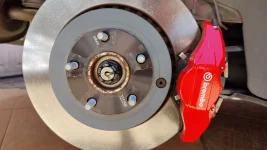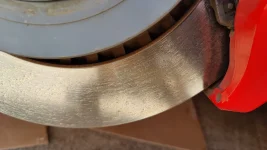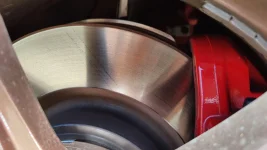I just perused through all 15 pages of this thread and I did not see anybody post pictures that show the core reason why a lot of us are changing brake pads. Well, here goes. Here is what my Stinger brake rotor looks like now, after doing the Brembo retrofit about 1-1/2yrs ago. Other than a couple of AutoX weekends (in Feb and March, so cold/cool weather), I don't really push the car hard in everyday driving. Still, the pad material transfer is very clearly visible on the rotor surface. I'm putting up with this, mostly because the deposition is fairly even all around the rotors, so I don't get any pulsation. That said, whenever I push the pedal a bit harder, I could feel - and hear - the grittiness that comes from the brake pads interacting with all the small deposits on the discs. The brake pads that came on these Brembo calipers are stock Stinger GT and they were in pretty good shape, so I took a chance on them. And I'm general happy I will probably end up getting a couple of years of use out of them, before changing out to better pads.
The rotors are perfectly fine. Other than the pad material deposition on them, the surface is almost glass smooth with no grooves. I see no reason to change them out with the brake pad change. Probably don't even need to have them turned. I'll measure them with a caliper when the time comes, and that will tell me what need done.
Have not decided yet which pads I'll go with. Semi-metallic for sure. Probably EBC, since I've used their motorcycle brake pads and like them a lot.
View attachment 46988
View attachment 46989
Now then, below are the 2021 G70 6MT. As many of you know, the 6MT version reportedly came with EuroSport pads that do not suffer from the pad material transfer problem. They also work much better at sustained high braking effort and temperature. As you can see below, mine did not disappoint. This is after 1yr of driving and 2 AutoX weekends (June & July), with my son and I both running in the same Heat, so the brakes got plenty toasty. There is absolutely none of the deposition that pepper the Stinger brake rotors above. There are some deposition, in the form of lines that show where the brake pad sat static, which is actually fairly normal and typically wear themselves out with use. If this isn't the case, you would not see just a couple of lines, you would see a whole lot of them.
The downside, of course, is much more brake dust, compared to the Stinger. This pic below is about 120 miles after last car wash, and the rims are already covered with a film of brake dust. IMO, it's a fair compromise with semi-metallic pads. I make a point of picking aftermarket rims that are easy to clean, for this very reason.
View attachment 46990View attachment 46991













